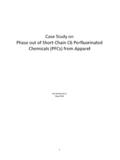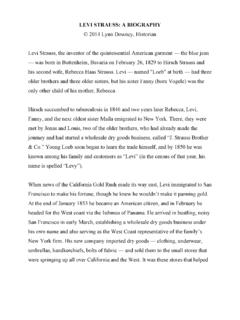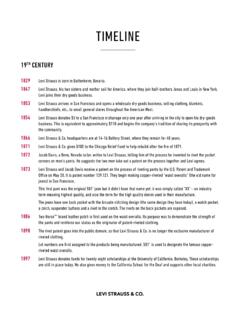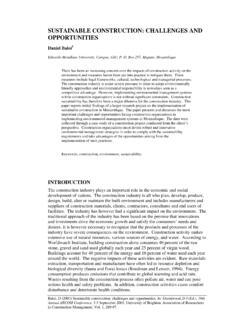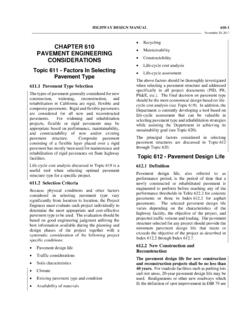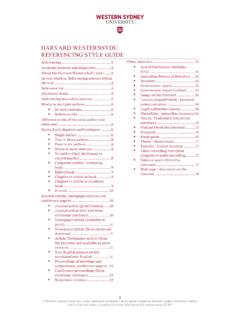Transcription of THE LIFE CYCLE OF A JEAN - Levi Strauss & Co
1 THE life CYCLE Understanding the environmental impact of a pair of Levi s 501 jeans LEVI Strauss & CO. 2015 OF A JEAN LEVI Strauss & CO. 2015 Levi Strauss & Co. (LS&Co.) conducted the apparel industry s first lifecycle assessment (LCA) study in 2007 to assess the entire lifecycle impact of a core set of products. The study focused primarily on the company s operations and uncovered that the greatest water and energy impact was in two areas: cotton cultivation and consumer care. Since then, LS&Co. has made tremendous progress addressing areas within its control, leading to more than one billion liters of water saved to date through the Levi s Water<Less process and implementation of the apparel industry s first water recycle/reuse standard in its supply chain.
2 The company has also taken bold steps to reduce the environmental impact of its products in the areas outside its direct control. This includes educating consumers through its Care Tag for the Planet initiative that encourages consumers to adopt care methods that use less energy and water. LS&Co. also joined the Better Cotton Initiative to invest in cotton that uses less water and chemicals and improves farmer livelihoods. In an effort to dig even deeper into the ways it can reduce its global impact, LS&Co. conducted a new global lifecycle assessment study to understand consumer behaviors by market and cotton agriculture globally. BACKGROUND LEVI Strauss & CO. 2015 The new study, initiated in 2013, looked at three LS&Co.
3 Products: a pair of Levi s 501 jeans, a pair of Levi s Women s jeans, and a pair of Dockers Signature Khakis. This latest study benefited from the latest advancements in LCA scientific methods, tools and data collection processes and gives greater insight into the two biggest impact areas by expanding the scope of data collected. This presentation dives deeply into the findings related to a pair of Levi s 501 medium stone wash jeans. The goal is that these findings will help LS&Co. and others in the apparel sector take more effective and holistic approaches to our industry s environmental impact. BACKGROUND WHAT IS AN ENVIRONMENTAL life CYCLE ASSESSEMENT? LEVI Strauss & CO. 2015 An LCA is a systems-based, quantitative method for evaluating the environmental impact of a product.
4 * It is a tool used to assess the stages and impact of a product s entire life , from raw material extraction (cradle) to waste treatment (grave). An LCA typically does not include: Social impacts Economic impacts lifecycle assessment DEFINITION *LS&Co. used the ISO 14040 Series as a basis for its LCA which details the requirements for conducting and administering a life CYCLE assessment LEVI Strauss & CO. 2015 lifecycle assessment BENEFITS Allows us to focus on the most significant environmental impacts as we develop and evaluate sustainability programs and policies Informs product decisions to reduce the environmental impact from design, materials, and manufacturing Supports engagement with external stakeholders to reduce the impact of materials and consumer care LEVI Strauss & CO.
5 2015 United States India Pakistan Brazil China Australia NEW AREAS STUDIED: GLOBAL COTTON CULTIVATION AND NEW CONSUMER MARKETS FUNCTIONAL UNIT Levi s 501 jeans & other core LS&Co. products PRIMARY DATA SOURCES LS&Co. 11 supplier factories 6 fabric mills STUDY CONDUCTED BY: Industrial Ecology Consultants and LS&Co. EVERY ASPECT ANALYZED Cotton production Fabric production Garment manufacturing Packaging Sundries Transportation & distribution Consumer care End of life LEVI S 501 PRODUCT ATTRIBUTES STUDIED 5 fabrics 8 finishes (low to high complexity; highest volume) 2012 production year MULTIPLE CONSUMER MARKETS INCLUDED United States United Kingdom France China WORLD S PRIMARY COTTON PRODUCING COUNTRIES STUDIED STUDY BASED ON LS&Co.
6 S product lifecycle categories and the required impact categories of the Sustainable Apparel Coalition s Product Category Rule guidance PANEL REVIEWED: Conforms with ISO 14040 and 14044 standards LEVI Strauss & CO. 2015 THE LEVI S 501 lifecycle LEVI Strauss & CO. 2015 THE lifecycle OF A LEVI S 501 JEAN LEVI Strauss & CO. 2015 CATEGORY DESCRIPTION UNITS CLIMATE CHANGE Global warming potential of greenhouse gases released to the environment kg CO2-e WATER INTAKE Freshwater taken from the environment liters WATER CONSUMPTION Net freshwater taken from the environment minus water returned to the same watershed at the same quality or better liters EUTROPHICATION Oxygen depletion as a result of nitrogen and phosphorous deposit into freshwater or marine environments g PO4-e LAND OCCUPATION Total land occupied to support the product system assessed m2-yr ABIOTIC DEPLETION A measure of the depletion of non-renewable resources that includes fossil energy.
7 Metals and minerals mg Sb-e SEVERAL IMPACT CATEGORIES RELEVANT TO APPAREL WERE ANALYZED LEVI Strauss & CO. 2015 IMPACT PHASE ANALYSIS SPANNED AREAS INSIDE AND OUTSIDE OUR DIRECT CONTROL EXECUTIVE SUMMARY OF OUR FINDINGS LEVI Strauss & CO. 2015 CONSUMER CARE AND COTTON CULTIVATION REMAIN THE MOST SIGNIFICANT IMPACT AREAS CONSUMER CARE COTTON CULTIVATION LEVI Strauss & CO. 2015 General Findings: Water Consumption: Fiber production, predominantly cotton, contributes by a wide margin to water consumption. Climate Change: Consumer care and fabric production are the most significant phases for climate change impact and energy. Expanded Scope: By expanding our scope to include the leading cotton-producing countries, we ve seen the water consumption from cotton cultivation increase to 68% of the total impact.
8 COTTON AND CONSUMER HABITS HAVE A BIG IMPACT ON WATER AND ENERGY USE Consumer Use Findings: Washing every 10 times a product is worn instead of every 2 times reduces energy use, climate change impact, and water intake by up to 80%. Significant differences between regions: Consumers in China are leading the pack: when it comes to laundering their jeans, they mostly wash in cold water and air dry American consumers had the highest water intake and use of non-renewable energy. The good news is that Americans more prevalently use cold water Consumers in the UK and France mostly air dry their jeans but they use more hot water than American or Chinese consumers Consumers in the USA, UK and France wash their jeans more frequently than in China LEVI Strauss & CO.
9 2015 Materials, Production and other findings: Fabric assembly, which includes yarn spinning, dyeing, weaving, and fabric finishing had notable contributions related to climate change impact and non-renewable energy consumption. life CYCLE stages that had minimal contribution to impact include: fabric transport, product transport, packaging, production wastes, distribution, retail, and end of life waste. OTHER STAGES STILL HAVE AN IMPACT, BUT TO LESSER DEGREES ON AUTO PILOT WHEN IT COMES TO WASHING YOUR JEANS? IT S TIME TO WASH LESS AND LINE DRY. LEVI Strauss & CO. 2015 LEVI S 501 JEAN lifecycle IMPACT Climate Change: kg Water Consumed: 3,781 Eutrophication: g 69 miles driven by the average US car 246 hours of TV on a plasma big-screen 3 days worth of one US household s total water needs The total amount of phosphorous found in 1,700 tomatoes The entire lifecycle of one pair of Levi s 501 jeans equates to: Land Occupation: 12 m2 Seven people standing with arms outstretched, fingertips touching, would form one side of a square this size LEVI Strauss & CO.
10 2015 CONSUMER WATER CONSUMPTION VARIES DEPENDING ON WASHING FREQUENCY AND EQUIPMENT Note: analysis is for one pair of pants worn by the average American consumer CONVENTIONAL WASHING MACHINE WASHING WEEKLY WASHING BI-WEEKLY WASHING MONTHLY 958 479 221 Liters EFFICIENT WASHING MACHINE WASHING WEEKLY WASHING BI-WEEKLY WASHING MONTHLY 659 330 152 Liters WATER INTAKE OVER ONE YEAR OF CARE LEVI Strauss & CO. 2015 EFFICIENT WASHING MACHINE THE CLIMATE CHANGE IMPACT OF CONSUMERS WASHING AND DRYING THEIR JEANS VARIES GREATLY DEPENDING ON WASHING FREQUENCY, METHODS, AND EQUIPMENT Note: for one pair of pants worn by the average American consumer CONVENTIONAL WASHING MACHINE WASHING WEEKLY WASHING BI-WEEKLY WASHING MONTHLY Kg CO2e CLIMATE CHANGE IMPACT FROM ONE YEAR OF CARE WASH IN WARM WASH IN COLD USE DRYER LINE DRY USE DRYER LINE DRY.





